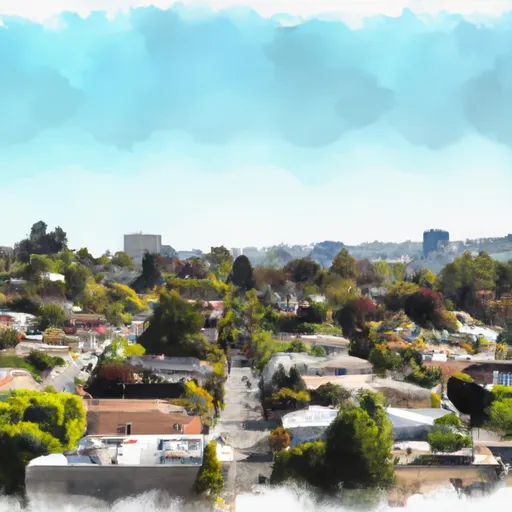-
 Snoflo Premium
Snoflo Premium
Get unlimited access to all our content
With no Ad interruptions! - Start Your Free Trial Login with existing account
Kenwood
Eden Index
Climate
10.0
•
Recreation
4.4
•
Community
3.5
•
Safeguard
6.4/10

Kenwood, California is a small unincorporated community located in Sonoma County. Situated in the heart of Sonoma Valley, Kenwood offers a pleasant Mediterranean climate characterized by warm dry summers and mild, wet winters. Summers are typically sunny with temperatures reaching the mid-80s, while winters see average temperatures in the mid-50s. The area is known for its beautiful vineyards and wineries, taking advantage of the favorable climate for grape cultivation.
Kenwood benefits from its location near the Mayacamas Mountains and is surrounded by diverse hydrology constituents. The community lies alongside the Sonoma Creek, which contributes to its scenic beauty. The creek provides critical water resources, supporting local agriculture and wildlife habitats.
Outdoor enthusiasts will find a range of recreational opportunities in Kenwood. The area is renowned for its hiking and biking trails, offering stunning views of the surrounding landscapes. Hood Mountain Regional Park, Sugarloaf Ridge State Park, and Jack London State Historic Park are all nearby, providing opportunities for nature exploration, camping, and picnicking. Additionally, Kenwood is a gateway to the renowned Sonoma Valley and its renowned wine country, making it an ideal destination for wine tasting and vineyard tours.
What is the Eden Index?
The Snoflo Eden Index serves as a comprehensive rating system for regions, evaluating their desirability through a holistic assessment of climate health, outdoor recreation opportunities, and natural disaster risk, acknowledging the profound impact of these factors on livability and well-being.
Climate Health Indicator (CHI): 10.0
Kenwood receives approximately
1027mm of rain per year,
with humidity levels near 63%
and air temperatures averaging around
15°C.
Kenwood has a plant hardyness factor of
9, meaning
plants and agriculture in this region tend to thrive here all year round.
By considering the ideal temperature range, reliable water supplies, clean air, and stable seasonal rain or snowpacks, the Climate Health Indicator (CHI) underscores the significance of a healthy climate as the foundation for quality living.
A healthy climate is paramount for ensuring a high quality of life and livability in a region, fostering both physical well-being and environmental harmony. This can be characterized by ideal temperatures, reliable access to water supplies, clean air, and consistent seasonal rain or snowpacks.
Weather Forecast
Streamflow Conditions
San Francisco Bay
Area Rivers
San Francisco Bay
Snowpack Depths
San Francisco Bay
Reservoir Storage Capacity
San Francisco Bay
Groundwater Levels
Recreational Opportunity Index (ROI): 4.4
The Recreational Opportunity Index (ROI) recognizes the value of outdoor recreational options, such as parks, hiking trails, camping sites, and fishing spots, while acknowledging that climate plays a pivotal role in ensuring the comfort and consistency of these experiences.
Access to outdoor recreational opportunities, encompassing activities such as parks, hiking, camping, and fishing, is crucial for overall well-being, and the climate plays a pivotal role in enabling and enhancing these experiences, ensuring that individuals can engage in nature-based activities comfortably and consistently.
Camping Areas
| Campground | Campsites | Reservations | Toilets | Showers | Elevation |
|---|---|---|---|---|---|
| Sugarloaf Ridge State Park | 49 | 620 ft | |||
| Cedar Creek OHV Dispersed - Knoxville RA | None | 1,476 ft | |||
| Spring Lake Regional Park | None | 295 ft | |||
| Sonoma County Fairgrounds RV Park | None | 173 ft | |||
| Lower Hunting Creek - Knoxville Rec Area | 5 | 1,077 ft | |||
| Bothe - Napa Valley State Park | None | 632 ft | |||
| Napa County Fairgrounds | None | 364 ft |
Nearby Fishing
Nearby Ski Areas
Catastrophe Safeguard Index (CSI):
The Catastrophe Safeguard Index (CSI) recognizes that natural disaster risk, encompassing floods, fires, hurricanes, and tornadoes, can drastically affect safety and the overall appeal of an area.
The level of natural disaster risk in a region significantly affects safety and the overall livability, with climate change amplifying these risks by potentially increasing the frequency and intensity of events like floods, fires, hurricanes, and tornadoes, thereby posing substantial challenges to community resilience and well-being.
Community Resilience Indicator (CRI): 3.5
The Community Resilience Indicator (CRI) recognizes that education, healthcare, and socioeconomics are crucial to the well-being of a region. The CRI acknowledges the profound impact of these elements on residents' overall quality of life. By evaluating educational resources, healthcare accessibility, and economic inclusivity, the index captures the essential aspects that contribute to a thriving community, fostering resident satisfaction, equity, and social cohesion.

